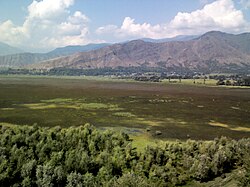Wular lake
| Wular Lake جھیل ولر |
|
|---|---|

Wular Lake
|
|
| Location | Jammu and Kashmir, India |
| Coordinates | 34°20′N 74°36′E / 34.333°N 74.600°ECoordinates: 34°20′N 74°36′E / 34.333°N 74.600°E |
| Primary inflows | Jhelum River |
| Primary outflows | Jehlum River |
| Basin countries | Jammu and Kashmir |
| Max. length | 16 km (9.9 mi) |
| Max. width | 9.6 km (6.0 mi) |
| Surface area | 12 to 100 sq mi (31 to 259 km2) |
| Max. depth | 14 m (46 ft) |
| Surface elevation | 1,580 m (5,180 ft) |
| Islands | Zainul Lank |
| Settlements | Bandipore |
| Designated | 23 March 1990 |
Wular Lake (also spelt Wullar) is one of the largest fresh water lakes in Asia. It is sited in Bandipora district in the Indian state of Jammu and Kashmir. The lake basin was formed as a result of tectonic activity and is fed by the Jhelum River. The lake's size varies seasonally from 12 to 100 square miles (30 to 260 square kilometers). In addition, much of the lake has been drained as a result of willow plantations being built on the shore in the 1950s.
In ancient times, Wular Lake was also called Mahapadmasar (Sanskrit: महापद्मसरः). Nilamata Purana also mentions it as Mahapadmasaras. Mahapadmasar is referred as Bolor by Al-Biruni {960–1031 AD}. The lake, with its big dimensions and the extent of water, gives rise to high leaping waves in the afternoons, called Ullola in Sanskrit, meaning "stormy leaping, high rising waves". Therefore, it was also being called Ullola. Its corrupted form saw its transition as Bolor by Al-Biruni and over the centuries corrupted further to Wulor or Wular. The origin may also be attributed to a Kashmiri word 'Wul', which means a gap or a fissure, appellation that must have come also during this period. The word Wul {Gap or fissure}, is also indicator of its origin to a fissure or gap created.
The lake is one of the 26 Indian wetlands designated as a Ramsar site. However it faces environmental threats including the conversion of large parts of the lake's catchment areas into agriculture land, pollution from fertilizers and animal wastes, hunting of waterfowl and migratory birds, and weed infestation in the lake itself.
Wular Lake is an important fish habitat, the main species being the common carp (Cyprinus carpio), rosy barb (Barbus conchonius), mosquitofish (Gambusia affinis), Nemacheilus species, Crossocheilus latius, and various snowtrout species in the genera Schizopyge and Schizothorax. Snowtrout species identified in the lake include the Sattar snowtrout (Schizopyge curvifrons), Chirruh snowtrout (Schizopyge esocinus), Schizothorax planifrons, Schizothorax macropogon, Schizothorax longipinus and Chush snowtrout (Schizopyge niger).
...
Wikipedia
